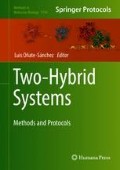Abstract
Protein–small molecule interaction studies provide useful insights into biological processes taking place within the living cell. A special yeast hybrid system, the yeast three-hybrid method, has been developed and used to explore proteins that bind to small molecules, by which means it may be possible to unravel biological processes and dissect function of biological systems. Here we present a protocol employing this method for identifying such binding proteins.
Access this chapter
Tax calculation will be finalised at checkout
Purchases are for personal use only
References
Hamdi A, Colas P (2012) Yeast two-hybrid methods and their applications in drug discovery. Trends Pharmacol Sci 33:109–118
Fields S, Song OK (1989) A novel genetic system to detect protein-protein interactions. Nature 340:245–246
Van Criekinge W, Beyaert R (1999) Yeast two-hybrid: state of the art. Biol Proced Online 2:1–38
Licitra EJ, Liu JO (1996) A three-hybrid system for detecting small ligand-protein receptor interactions. Proc Natl Acad Sci U S A 93:12817–12821
Lin H, Abida WM, Sauer RT et al (2000) Dexamethasone–methotrexate: an efficient chemical inducer of protein dimerization in vivo. J Am Chem Soc 122:4247–4248
de Felipe KS, Carter BT, Althoff EA et al (2004) Correlation between ligand-receptor affinity and the transcription readout in a yeast three-hybrid system. Biochemistry 43:10353–10363
Tran F, Odell AV, Ward GE, Westwood NJ (2013) A modular approach to triazole-containing chemical inducers of dimerisation for yeast three-hybrid screening. Molecules 18:11639–11657
Wang Y, Letham DS, John PC et al (2016) Synthesis of a cytokinin linked by a spacer to dexamethasone and biotin: conjugates to detect cytokinin-binding proteins. Molecules 21:E576
Cottier S, Mönig T, Wang Z et al (2011) The yeast three-hybrid system as an experimental platform to identify proteins interacting with small signaling molecules in plant cells: potential and limitations. Front Plant Sci 2:101
Becker F, Murthi K, Smith C et al (2004) A three-hybrid approach to scanning the proteome for targets of small molecule kinase inhibitors. Chem Biol 11:211–223
Saghbini M, Hoekstra D, Gautsch J (2001) Media formulations for various two-hybrid systems. In: MacDonald PN (ed) Two-hybrid systems: methods and protocols, Methods in molecular biology, vol 177. Humana Press Inc., Totowa, NJ, pp 15–39
James P, Halladay J, Craig EA (1996) Genomic libraries and a host strain designed for highly efficient two-hybrid selection in yeast. Genetics 144:1425–1436
Parchaliuk DL, Kirkpatrick RD, Simon SL et al (1999) Yeast two-hybrid system: part A: screen preparation. Tech Tips Online 4:6–15
Selivankina SY, Karavaiko NN, Maslova GG, Zubkova NK, Prokoptseva OS, Smith AR, Hall MA, Kulaeva ON (2004) Cytokinin-binding protein from Arabidopsis thaliana leaves participating in transcription regulation. Plant Growth Regul 43:15–26
Author information
Authors and Affiliations
Corresponding author
Editor information
Editors and Affiliations
Rights and permissions
Copyright information
© 2018 Springer Science+Business Media, LLC, part of Springer Nature
About this protocol
Cite this protocol
Wang, Y., Letham, D.S., John, P.C.L., Zhang, R. (2018). Using Yeast Hybrid System to Identify Proteins Binding to Small Molecules. In: Oñate-Sánchez, L. (eds) Two-Hybrid Systems. Methods in Molecular Biology, vol 1794. Humana Press, New York, NY. https://doi.org/10.1007/978-1-4939-7871-7_14
Download citation
DOI: https://doi.org/10.1007/978-1-4939-7871-7_14
Published:
Publisher Name: Humana Press, New York, NY
Print ISBN: 978-1-4939-7870-0
Online ISBN: 978-1-4939-7871-7
eBook Packages: Springer Protocols

